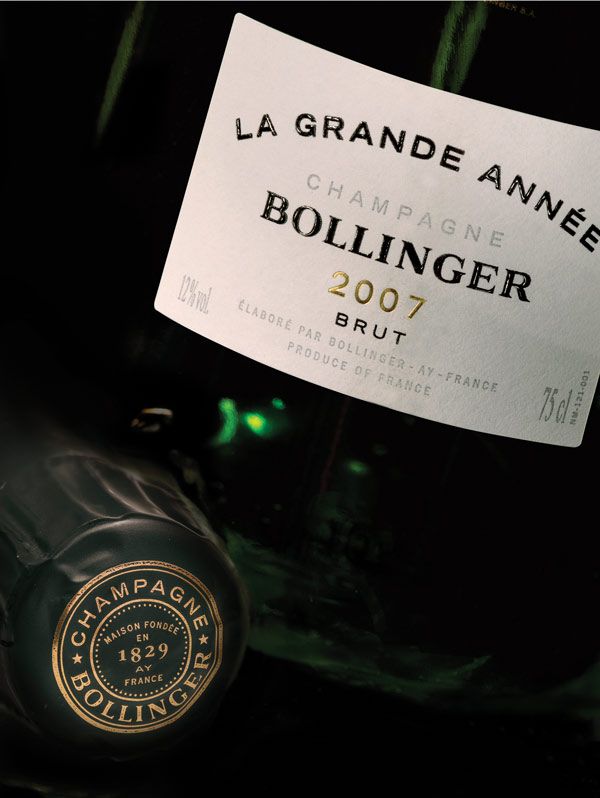Bollinger: The Nectar of the Gods
Champagne has never been just a wine. It has long been recognised as something special, and until recent times, something that has only been enjoyed by nobility. Often referred to as, “the Nectar of the Gods”.
Champagne can only be called Champagne if it comes from the Champagne region – an area that rarely sees temperatures above 10 °C and with earth that is so chalky you’d wonder what else would grow there. But these are the “Grand Crus” that make this place so special and recognised since Roman times for its ability to deliver some of finest wines.
While the earlier results of bubbly wines were considered the result of bad winemaking, it is the work of Benedictine monk, Dom Perignon, who managed to commercialise the style known today as “Champagne”. Presented to the nobility of Europe through the house of Louis XIV, it soon became a hit across Europe and something synonymous with celebration.
 “I drink champagne when I win to celebrate and I drink when I lose to console myself”, Napoleon Bonaparte once famously said.
“I drink champagne when I win to celebrate and I drink when I lose to console myself”, Napoleon Bonaparte once famously said.
To this day Champagne is the drink we reach for whenever there is a celebration, and, thankfully, it is no longer just the domain of nobility.
Bollinger’s roots in the Champagne region date back to 1359 when the Hennequins (one of the founding families of Maison Bollinger), settled in the region, buying land and vineyards. But, like most aristocrats at the time, it was considered beneath them to get involved in something as ‘unsavoury’ as commerce, so any wine produced and not consumed by the family was sold to friends.
The name Bollinger however didn’t come into the picture until 1829 when Joseph Jacob Bollinger – a German with a fascination for Champagne – proposed a joint venture between him, cellar master Paul Renaudin and Hennequin de Villermont. Leaving the Villermonts name out of it, the House of Renaudin-Bollinger was established. The name Renaudin remained on their labels until 1960 well beyond 1837 when the marque became wholly owned by the Bollingers.
Today the House of Bollinger is not only outstanding for the production of Champagne of the highest quality but is also one of the last independent Champagne houses, having remained in family hands for generations.
Several strokes of genius over the years have ensured that Bollinger to this day is recognised as one of the most admired Champagne brands in the world. It starts with the early marketing efforts of Joseph Bollinger, who eventually naturalised as a French citizen and adopted the more French sounding name ‘Jacques’. Bollinger established a network of sales agents across Europe and ultimately turned his attention to England where he paired up with fellow German, Ludwig Mentzendorff in 1858. Mentzendorff began distributing Bollinger and the company has remained Bollinger’s British agency ever since.
Bollinger has also long been a favourite of the Royals. Often affectionately referred to as ‘Bolly’ by devotees, the term came from Edward, Prince of Wales. He would always have a bottle at hand when going on hunts and would refer to to it as ‘a bottle of the boy’ which led to the abbreviated reference of ‘Bolly’.Queen Victoria issued Bollinger the “Royal Warrant” and Bollinger has retained warrant to carry the word “by Royal Appointment” ever since. Bolliger is often the Champagne of choice at royal occasions – frequently served at royal weddings.

Bollinger has also managed to make an impression on popular culture as James Bond’s Champagne of choice. A deal was struck at a wine soaked meeting in France in 1978 between Christian Bizot, GM of Champagne Bollinger, and Bond Movie producer, Albert “Cubby” Brocolli. The pair struck up a close friendship and a handshake deal that has persevered to this day.
Don’t forget, it was always “a bottle of ‘Bolly’ darling” that the AB Fab girls had on hand for breakfast lunch and dinner.
“I drink Champagne when I’m happy and when I’m sad. Sometimes I drink it when I’m alone. When I have company I consider it obligatory. I trifle with it if I’m not hungry and drink it when I am. Otherwise, I never touch it – unless I’m thirsty” – Madame Lily Bollinger, Head of the House of Bollinger until 1971.
You’ll notice that Bollinger don’t refer to the Non-Vintage range as “Non-Vintage” either. By suggestion of their British agents at Mentzendorff, they started calling this range “Special Cuvee” since at least half of the wine used is cask fermented. It was also Maison Bollinger that created the Charter of Ethic and Quality for Champagne, thereby making it very clear that there are champagnes – and then there is Bollinger.
“There is no limit to quality”, Christian Bizot, – nephew of Madame Lily Bollinger.
Many Champagne houses under corporate management have bowed to pressure to produce volume, meaning that wine is sourced from areas outside of the Champagne region. Technically speaking, Champagne can only be Champagne if produced in the Champagne region. As a consequence, wines from these houses are heavily discounted, sometimes below $50 a bottle.
Bollinger on the other hand have always remained steadfast in maintaining the highest quality, so you’ll rarely see a bottle of Bollinger for under $100. Bollinger, therefore, has maintained a very high status and to serve Bollinger is a mark of success.
This is why Bollinger is also the M2’s Champagne of choice. We have been serving Bollinger at the M2 Man of the Year Awards for more than ten years. Last year, Bollinger took over the highly coveted sponsorship of the awards. It is only appropriate that a lavish celebration of success recognising New Zealand’s most successful men has glasses of Bollinger held high – a true mark of excellence to look to up to.

